Figures & data
Figure 1. Dynamic allosteric forms of GR allow its diversity of responses. (A) Context-dependent parameters influence in time and space the availability of the various proteinous, chemical, and nucleic acid ligands of GR. (B) BDNF is an example of an activity-dependent factor that provides molecular and cellular context to GR signaling and diversity of responses. In this example, context A (but not B) and the presence of BDNF will induce the phosphorylation of GR and thus induce a differential response. (C) A principal component analysis of most regulated gene sets in cortical neurons stimulated with BDNF or dexamethasone (Dex) alone or in combination (BDNF + Dex). The transcriptional gene network elicited by coincident signals is distinct from the sum of individual gene modules (ref. Lambert et al., Citation2013). PC: principal component.

Figure 2. Timing of glucocorticoid signaling with neuronal activity impacts the adaptive response of individual cells and in networks. (A) Glucocorticoid-induced plasticity of dendritic spines is influenced in time and space by context-dependent mechanisms across cells and networks. Maps of dendritic spine synapses are reorganized as a function of glucocorticoid (GC) physiological rhythmic secretions and contextual experiences. Optical erasure of one such synaptic map of learning impairs behavioral performance. Boxes show rules of glucocorticoid spine plasticity and interaction with context (Arango-Lievano et al., Citation2015a; Liston et al., Citation2013; Moda-Sava et al., Citation2019). (B) Types of tissue responses to glucocorticoid receptors (GR). Mosaic responses depend on context at stimulation to make GR ligands available in time and space. Such mosaic may represent cellular assemblies in functional network. (C) Phosphorylation is one type of post-translational modification that can modify GR allostery and its availability to ligands in time and space. Glucocorticoid-dependent phosphorylation of GR follows the homogenous model whereas BDNF-dependent phosphorylation of GR follows the network model and is co-expressed with the cellular marker of activity c-fos in pyramidal cortical neurons labeled with thy1-YFP reporter (Ref. Arango-Lievano et al., Citation2019). GC: glucocorticoids; GR: glucocorticoid receptor.

Figure 3. Adaptive plasticity through diversity of responses to glucocorticoid hormones underlies individual differences among adaptive trajectories to stress and between resiliency or vulnerability to stress-related disorders. Contextual factors involved in maladaptive stress responses influence the susceptibility to stress-related disorders. Glucocorticoid receptors operate as coincidence detectors between the HPA axis activity and the environmental context to update the precision and maintain diversity of response based on prior experience. For example, the GR employs a diversity of allosteric/orthosteric forms and post-translational modifications across a diversity of chromatin landscapes in multiple cell types and neuronal networks to promote pleiotropic cellular, physiological and behavioral responses based on the variety of demands in the brain and body. Insights from clinical and rodent studies show that the individual variability in susceptibility or resilience to stress-related disorders results from a complex interplay between the perceived stress, context-dependent factors (genetic predisposition, history of stress, ongoing experience) and changes in BDNF and GR signaling pathways across large-scale brain networks. The capacity of an organism to deal with a chronic activation of the HPA axis (increased allostatic load) determines the extent of behavioral, physiological, neuroendocrine and neuronal changes in brain regions regulating cognition, reward, fear, emotionality and social behaviors. GC: glucocorticoids; VTA: ventral tegmental area; Hypoth.: hypothalamus; HPA axis: hypothalamo-pituitary-adrenal axis.

